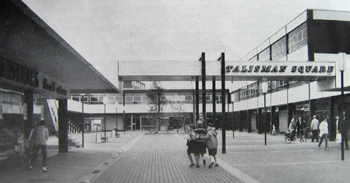Supermarkets and Talisman Square
(Published KWN, 12th October 2007, as Waitrose’s arrival and Talisman Square rebuild was anticipated)

Talisman Square with Bishop’s on the left (now Boots with an extended front); from a late 1960s Town Guide
With a major new supermarket soon to be built, and other building work in progress, it is worthwhile to look back at the early development of Talisman Square and of supermarket shopping in Kenilworth.
In 1962, Abbey End was still a bomb-site, and the tannery buildings in the centre of the town still stood, but at 2 Warwick Road, Fine Fare opened the town’s first supermarket, although they referred to it as a self-service grocers. In response, a well-established local grocer, E H Watts at 30-32 Warwick Road, converted at least part of his business over to self-service, perhaps sufficiently to be able to be called Kenilworth’s own supermarket. Typically of local grocers, he offered home delivery.
At the time, there were many concerns about the generally run-down state of the town and that it lacked appeal; articles appeared in the Kenilworth Weekly News with headlines such as “What Can Kenilworth Offer?” – one of many stories of the era that are mirrored today. However, the demolition of the tannery and some associated buildings fronting Warwick Road, paved the way for the building of what became the town’s first shopping precinct, Talisman Square. When the first of the new buildings became visible in late 1964, there was major disquiet over the choice of black bricks, but the council were unrepentant and announced they were to use the same colour on the other planned new shops at Abbey End. There were also many protests over another planned re-development, an 8-storey hotel opposite the Abbey End site.
The first shops opened in the precinct in mid-1965, and one of the first was a second supermarket, Bishop’s. It was the Middlesex based company’s 55th store but its first in the Midlands, the previous furthest north being in Dunstable. The owner’s were quick to point out that they thought of it not as a “supermarket” but as a “food store”. It’s floor space of 3,300 sq ft was not cluttered with too many shelving racks but had “breathing space” for the customers and included a delicatessen, only the second Bishop’s store to have one. Behind the scenes, conveyor belt systems were used to transfer merchandise from delivery lorries to the store-rooms above the shop, and from there to the shop itself. Meat, from Smithfield, and cheese were prepared and packed on the premises. With the exception of the manager, all the staff were from Kenilworth, and wore the sky-blue uniform that earned them the nickname “Bishop’s Bluebell Girls”.
There were major reservations over the effect the development would have on established traders. Fearing the worst, the Kenilworth Chamber of Trade announced that the only chance for all shops to survive was to attract out-of-town customers, and they would need improved parking facilities.
As well as being the first to open, Fine Fare became the first Kenilworth supermarket to close, and the premises were taken over by Bejams, a store that sold only frozen food and the freezers in which to keep it. In 1989, Bejams were bought out by their northern rivals Iceland who remain in the same building today.
Two more Supermarkets arrived in the 1970s; first Keymarket in a new building in The Square and then KwikSave, taking over the premises formerly occupied by the Kenilworth Indoor Market at 34 Warwick Road. In the mid-1980s, the Keymarket name was bought by Bristol based Gateway (so called as Bristol is the “Gateway” to the west-country), and soon after the Kenilworth store name was changed.
Bishops were taken over by Budgens, who in 1980 opened a new enlarged store in Station Road built on the former bowling green of the Kings Arms Hotel. Boots the Chemist moved across Talisman Square to take over the vacated premises, and they still occupy them today. This left the precinct without a supermarket.
In October 1996, after a refurbishment, Gateway re-opened as Somerfield, but the following year saw the arrival of a major competitor, complete with it’s own car park – Sainsbury’s. It was inevitable that other supermarkets were likely to struggle once Sainsbury’s was established, and KwikSave, by then owned by Somerfield, was the first to go, closing on October 7th 2000. The premises were taken over by clothing retailers, Peacocks. Four years later, Budgens closed (the building remains empty) leaving just two supermarkets and a frozen food shop.
The arrival of Waitrose will result in Kenilworth having its largest ever total of supermarket floorspace by some distance. With prophetic words echoing from the 1960s, it is again feared that there will be retailing casualties unless numerous out of town shoppers can be attracted.
Footnote: Since the above was published, I have since discovered that the claim to be Kenilworth’s first self-service grocery store, pre-dating the purpose built Finefare, was Windy Arbour Stores. Also, the “empty” Budgeons building is now occupied by Wilkinsons.